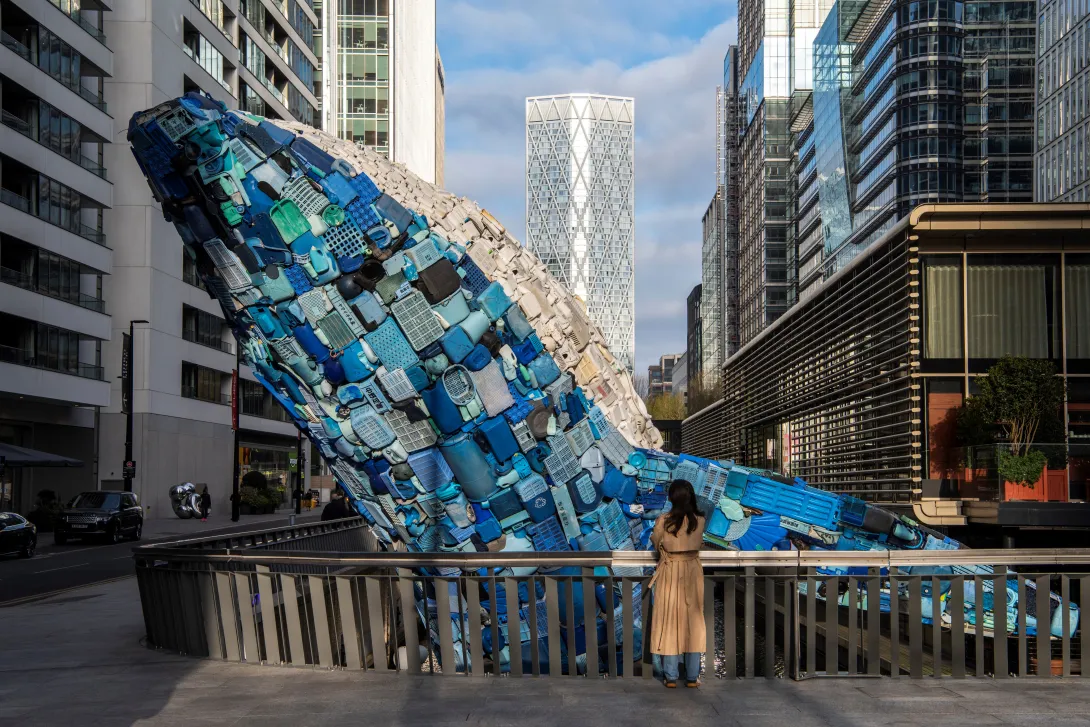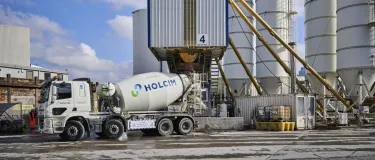Holcim uk brews up coffee concrete to support new whale sculpture in canary wharf
Leading sustainable construction solutions provider Holcim UK has created an innovative concrete mix using recycled coffee grounds to support a 12m high sculpture of a blue whale just unveiled in London’s Canary Wharf.

The Whale on the Wharf (Skyscraper) by StudioKCA was created from plastic waste recovered from the Atlantic and Pacific oceans and has been sited in a wet dock in Canary Wharf’s Wood Wharf district.
But the four-storey high structure required firm counter-weight foundations to keep it and its frame in place.
So, Canary Wharf Group (CWG) turned to Holcim UK to develop an innovative concrete to support it and the circular economy message the sculpture embodies.
Holcim experts devised a concrete mix containing biochar sourced from coppiced UK fast growing hard woods and spent coffee grounds from Canary Wharf’s cafes and restaurants to form the structural supports to anchor the sculpture in place.

Five loads (32 cubic metres) were mixed and batched at Holcim UK’s Battersea Readymix plant before being delivered to site. A specialist civil engineering diving company, DiveCo Marine Limited, then pumped the product into place under the water’s surface. The new sculpture was unveiled to the public this week. (April 9)
Holcim UK, working with counterparts at the Holcim Innovation Centre in Lyon, has been testing the use of biochar in readymix concrete for a number of years.
Biochar is widely used in agriculture and is produced by heating biomass, typically sourced from surplus wood, at temperature and in the absence of oxygen, through a process called pyrolysis. The result is a black carbon rich material like charcoal. Similarly, spent coffee grounds can be turned into a carbon rich biochar when treated through pyrolysis.

The process of creating biochar can help prevent the formation of greenhouse gases which are generated when biomass waste (and used coffee) is sent to landfill and naturally degrades, releasing carbon dioxide and in some instances methane.
When biochar is added to concrete, the sequestered carbon is removed from the carbon cycle for a very long period of time - in a way, the carbon is ‘trapped’ and prevented from returning into the atmosphere as CO2. Through using biochar you also use less virgin or primary aggregate preserving natural resources for longer, as well as less waste being sent to landfill or incinerators.
The mix produced to support the whale sculpture was formulated with carbon-reducing limestone fines and GGBS. With the addition of the 'Bio-Espresso' biochar, the embodied carbon was able to be lowered by a further 66%, yielding an impressive next-generation concrete with a projected net Global Warming Potential or GWP (A1-A3), as low as 69 kg CO₂e/m³.
With the two technologies combined, the total carbon reduction is about 79% compared to a traditional CEMI concrete mix.

Jasen Gauld, National Concrete Solutions and Product Development Director for Holcim UK, said: “We have a really good ongoing relationship with CWG. They approached us regarding the project and the need for an innovative and new concrete to support The Whale on the Wharf. It was essential that the concrete conveyed a new message of circularity, sustainability, and a bold approach to tackling carbon.
"Collaborating with the Holcim Innovation Centre in Lyon, we have been developing and testing the use of biochar in concrete, confident it would be an ideal solution. It’s a technology we are really excited about, not just because it helps sequester carbon and lower the embodied carbon in concrete, but also because it aligns so well with the circular economy.
"As we kept talking about the project, CWG was keen to see if we could add its spent coffee grounds into the biochar raw feed. We figured out how to make it work, and our Product Development Innovation Manager, Sam Oscroft, even dubbed it the ‘Bio-Espresso biochar’ in our laboratories.
"The final ready-mix concrete is fully code-compliant and performs just as expected. Plus, we have incorporated a biomass material that can lock CO2 into the concrete, while recycling waste that would normally decompose and release greenhouse gases."

Jonathan Ly, Director for Structures at Canary Wharf Group, said: “This is a pioneering moment for CWG and our partners. A UK first, the Whale on the Wharf (Skyscraper) project has provided us with a unique opportunity to test this innovative use of spent coffee grounds as a material in biochar, moving us ever closer to our net zero goals.
“Thanks to CWG’s in-house waste management system, we are able to turn something once considered as waste, into a fruitful building material, saving significant carbon from entering the atmosphere.
“We are proud to be the first UK developer to use this coffee biochar mix in our concrete, embedding the principles of a circular economy in our design and construction process. I can’t wait to see where we can take this in our future projects and prove what we can do when working as a collective.”
For more information visit www.holcim.co.uk
Press contacts
Telephone
01530 510066
Email
"Biochar is a technology we are really excited about for its ability to lower embodied carbon in concrete but also how it embraces the circular economy too."
- Construction Industry Leader Commits to Ambitious Sustainability Mission With Rebrand To Holcim UK
- Head office has a bright future after adopting solar power
- Glensanda 200 millionth tonne sets sail
- 2025 edie Awards: Holcim UK scoops double nomination
- Green shoots of growth start to flourish in sustainability efforts
- Holcim UK Welcomes First Ship To New Deep-Sea Cement Terminal at the Port of Southampton
- Key construction milestone reached with inflation of ground-breaking dome silo at Tilbury Docks
- Strengthening UK Infrastructure Resilience: Holcim UK Calls for Urgent Action Following ‘Biblical’ Rainfall
- Innovative carbon removal technology lands in the UK






